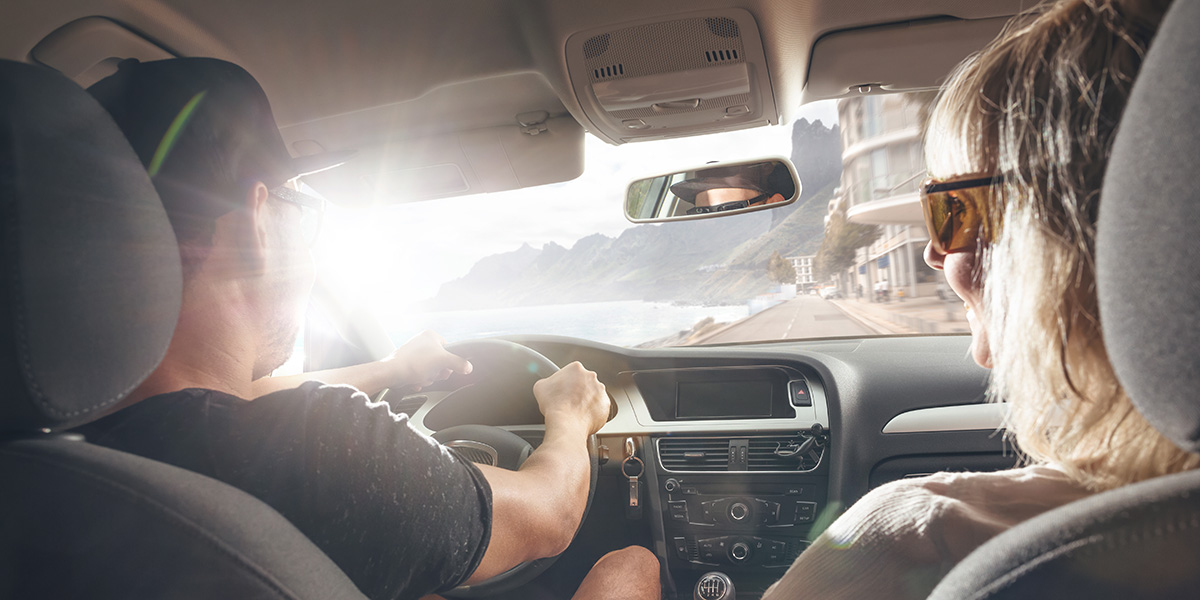

Complete guide to renting a car in Spain for 2025
Renting a car in Spain unlocks freedom’s golden road—where coastlines whisper, mountains call, and every mile hums with discovery’s promise.
You’ve mapped out your dream trip, but one thing’s still up in the air—will renting a car in Spain be worth it? This guide breaks it all down: rental tips, where to find cheap prices, all requirements, and must-know advice to help you decide before you grab the keys.
Tento článok obsahuje affiliate odkazy.

1. Should you rent a car in Spain?
Thinking about renting a car in Spain? It’s a solid option—if it fits how you like to travel. Spain’s public transport is great, especially in cities, but if you’re craving wide-open landscapes, spontaneous detours, and tiny villages far from train lines, a rental might just be the right call.
If your itinerary leans rural or off-the-grid, or you want the flexibility to stop wherever you like, renting a car in Spain can be a game-changer. But if you’re sticking to major cities or want to avoid the hassle of driving abroad, Spain’s trains and buses might be all you need.
Pros
- You’ve got full freedom to roam. No schedules, no rushing—just the open road and whatever catches your eye along the way.
- If you’re traveling with others, splitting the cost of fuel and rental makes it easier on your wallet.
- Spain’s rural gems—think olive groves, cliffside roads, whitewashed towns—are best explored by car.
- Hauling gear or heavy bags? No need to drag them through stations—just pack the trunk and go.
Cons
- Driving in cities like Madrid or Barcelona can be a headache. Traffic’s thick, parking is scarce, and garages aren’t cheap.
- Watch out for sneaky rental fees and questionable insurance upsells. Some companies don’t have the best rep.
- Tolls can add up quickly, fuel’s not exactly cheap, and automatics often cost more (and can be hard to find).
- Navigating unfamiliar road rules, signage, or twisty mountain roads can be a bit stressful, especially if you’re not used to it.
2. Where to find a cheap car rental in Spain?
Visitteo
You know how the same rental car can show up with five different price tags depending on where you look? That’s where Visitteo steps in. Instead of bouncing from site to site, comparing deals and wondering if you’re missing something better, Visitteo lines up prices from all the major rental companies in one spot. It does the behind-the-scenes work so you don’t have to. It’s the smart way to search without second-guessing.
EconomyBookings
Trying to save a bit on your trip? EconomyBookings is a solid place to start. They pull together offers from tons of providers, so you’ve got plenty of options—whether you need a compact car for city cruising or something roomier for a road trip. The site’s pretty straightforward, and prices are often lower than you’d expect. That said, take a moment to read the fine print, especially around insurance.
Discover Cars
It compares real deals from trusted companies, showing you the kind of prices that make you feel like you’ve found a travel hack. The booking process is smooth, support is there when you need it, and the variety of vehicles means you’ll likely find just what you’re looking for. Whether it’s a short hop or a full-blown road trip, Discover Cars keeps it easy and stress-free.
3. Requirements for renting a car in Spain
Here’s what you’ll need to rent a car in Spain, broken down clearly:
- Minimum Age: Most rental companies require drivers to be at least 21 years old. If you’re under 25, expect a young driver fee. Some providers may require you to be 23 or older, especially for certain car categories.
- Driver’s License: You must have a valid driver’s license held for at least one year.
- International Driving Permit (IDP): Required for travelers from outside the EU, especially from the U.S., Canada, or Australia. Even when not mandatory, it’s often requested.
- Passport or National ID: You’ll need this for identity verification when picking up the car, alongside your license.
- Credit Card: A credit card in the main driver’s name is required to hold the security deposit. Debit and prepaid cards are usually not accepted.
- Insurance: Third-party liability insurance is legally included. Still, adding collision damage waiver (CDW) or theft protection is highly recommended—either through the rental agency or your own insurance provider.
4. What type of car should I rent in Spain?

Picking the right rental car in Spain really comes down to where you’re headed and how you like to travel.
If your plans revolve around cities like Madrid, Barcelona, or Seville, stick with something small—an economy or compact car will save you serious headaches when it comes to parking and squeezing through tight streets.
Now, if you’re dreaming of winding drives through Andalusia, road-tripping along the Costa Brava, or exploring the hills of the Basque Country, a mid-size car or SUV might be worth the upgrade. It’ll give you more comfort, especially on longer stretches or rural roads.
Heading into the mountains or smaller villages? Go for something with solid suspension and good handling, especially in cooler months. And if you’re traveling light? A fuel-efficient hatchback is hard to beat.
5. Make sure you get insurance coverage
Most rental cars in Spain come with basic insurance, but here’s the thing—there’s often a steep deductible tucked into the fine print. If something goes wrong, you could be on the hook for €1,000 or more. Not exactly the kind of surprise you want mid-vacation. That’s why it pays to understand your options before you hit the road.
- CDW (Collision Damage Waiver) covers damage to the rental car, but usually leaves you with a sizeable excess.
- Theft Protection kicks in if the car’s stolen, but again, it rarely covers the full cost without extra coverage.
- Super CDW or Full Coverage is your best bet if you want peace of mind—this kind of policy can reduce your liability to zero.
Before you automatically agree to the pricey add-on at the rental counter, take a moment to check your credit card benefits. Many cards already offer CDW coverage in Spain. Still, for full protection and less stress, you might want to consider picking up zero-excess or reimbursement insurance ahead of time. It’s usually cheaper—and way less painful if anything goes sideways.
6. Best airports in Spain to start your journey

Planning a trip to Spain? The airport you fly into can do more than just kick off your journey—it can shape your entire experience. With well-connected hubs and easy access to rental cars, it’s simple to start exploring the country the moment you land.
Touching down in the heart of Spain? Affordable car rental at Madrid Airport gives you a solid base for road trips in any direction—north to wine country, south to Andalusia, or east toward the Mediterranean.
If coastal drives and mountain escapes are on your list, Barcelona Airport rental cars make it easy to head off in just about any direction—whether it’s the Costa Brava or the Pyrenees. For a deeper dive into the south, Seville Airport car hire options are perfect for exploring flamenco towns, Moorish architecture, and the rolling hills of Andalusia.
Craving something less traveled? Pick up a rental car at Zaragoza Airport and explore Spain’s quieter northern regions, dotted with medieval towns and dramatic landscapes. History and mountain views more your thing? Granada Airport rental car services give you quick access to the Alhambra and the Sierra Nevada.
If you’re heading east, Valencia Airport car hire offers put beach days and vibrant neighborhoods just a short drive away. Exploring the islands? Palma Mallorca Airport car rental deals are great for hitting the coastal roads and tucked-away coves of Mallorca.
Down south, Malaga Airport vehicle hire deals set you up for a relaxed journey through whitewashed villages and seaside resorts. And if you’re flying into the southeast, Alicante Airport rent a car services make it easy to cruise the Costa Blanca at your own pace.
7. Top tips for renting a car in Spain
Book in advance. As soon as your flights are locked in, start looking at rental cars. Booking early not only gets you better prices, but also gives you more choice—especially during peak travel seasons when demand spikes.
Compare prices on Visitteo. Don’t waste time bouncing between tabs. With Visitteo, you can compare rates from all the major car rental companies in one go, making it easy to spot the best deal without the usual hassle.
Check for hidden fees. Before you hit that “confirm” button, take a minute to scan for extra charges. Airport pick-up fees, young driver surcharges, or fees for additional drivers can sneak in and seriously bump up the total cost.
Understand mileage limits. Planning to clock in a lot of kilometers? Make sure your rental includes unlimited mileage—some deals look great upfront but come with strict distance caps that’ll cost you later.
Know the cancellation policy. Life happens, and plans change. Look for a rental with free cancellation or flexible terms so you’re not stuck paying for a car you can’t use.
Inspect the car. Walk around it before driving off. Snap photos of any dents, scratches, or scuffs—just in case there’s a dispute when you return it.
Know the local driving rules. Spain’s road laws might differ from what you’re used to. Brushing up on speed limits, toll roads, and signage could save you from fines—or worse.
Bring your GPS. Skip the pricey add-on and use your phone. Apps like Google Maps or Waze work great in Spain, and you’re already familiar with how they work.
8. Best places to explore in Spain by car

Andalusia. Southern Spain was practically made for road trips. From the flamenco streets of Seville to the ancient alleyways of Córdoba and the dramatic cliffs of Ronda, every stop feels like a postcard. It’s culture, color, and countryside all in one drive.
Granada. Tucked beneath the Sierra Nevada mountains, Granada is a must. Cruise through winding roads, then explore the legendary Alhambra and the city’s blend of Moorish roots and modern buzz. It’s the kind of place that lingers with you.
Costa Brava. Head north of Barcelona and you’ll find coastal drives that are anything but ordinary. Think rugged cliffs, tucked-away beaches, and villages like Cadaqués that seem frozen in time.
Picos de Europa. For something wilder, venture into Spain’s northern peaks. The roads twist through dramatic mountain landscapes and sleepy stone hamlets. It’s peaceful, scenic, and completely underrated.
La Rioja. If wine is your thing, this region delivers. Drive through rolling vineyards, stop for tastings, and soak in the slow pace of medieval towns surrounded by open skies.
Valencia to Alicante. Want sunshine and sea views? This stretch of coast is packed with beautiful beaches, relaxed towns, and some of the best paella you’ll ever taste. Perfect for a laid-back, scenic drive.
9. Car breakdowns and accidents
Car breakdowns. It’s not exactly part of the dream road trip, but if your car breaks down in Spain, don’t stress—it happens, and it’s manageable. Most rental companies offer 24/7 roadside assistance, and the number should be easy to find on your rental paperwork or key fob. Call them as soon as possible. In the meantime, pull over somewhere safe, switch on your hazard lights, and—if you have one—set up the warning triangle a good distance behind the car. The key is to stay calm and make yourself visible while help’s on the way.
Car accidents. If you’re involved in an accident, your first move is to call 112—that’s Spain’s emergency number. Make sure everyone’s okay, then contact your rental company to report what happened. Take photos of everything: the cars, the damage, the road, even license plates—those little details can matter later. Swap info with the other driver, but here’s the golden rule: don’t admit fault, even if things seem obvious. That part’s for the insurance companies to figure out. It’s never a situation anyone hopes for, but knowing what to do can make a world of difference.
FAQs
Definitely—if you’re planning to go beyond the big cities. A car opens the door to places you’d never reach by train or bus, from quiet hilltop villages to remote coastal roads. It gives you total freedom to explore on your terms.
Yes, basic insurance—usually third-party liability—is included by law. But here’s the catch: it often comes with a high excess. That means if something goes wrong, you could be left covering a chunk of the damage. Extra coverage is worth considering.
In most cases, yes. Just let the rental company know ahead of time. There may be a cross-border fee, and not all countries are allowed, so always double-check the fine print before you go international.
If you’re from the EU, your regular license is fine. But travelers from countries like the U.S., Canada, or Australia will likely need an International Driving Permit. Some rental companies insist on it, so it’s better to be safe than stuck at the counter.
Yes, one-way rentals are usually allowed. Just be prepared to pay a drop-off fee. It’s a handy option if you’re flying out from a different city—but make sure to book this setup in advance.
Speed limits typically break down like this:
- 50 km/h in towns
- 90 km/h on secondary roads
- 120 km/h on highways
Absolutely. Roads are generally in great condition, and Spanish drivers tend to follow the rules. That said, stay sharp in cities—roundabouts can be a bit chaotic, and old town streets can get tight. Give yourself time, and you’ll be fine.
You’ll need a valid driver’s license, a credit card in your name, and a passport or ID. Book early for the best rates, check the fuel and mileage policies, and always read the insurance details. A little prep goes a long way at the rental desk.
Not technically, but it’s often a smart move. The included coverage won’t protect you fully, and that excess can be expensive. Full coverage or zero-excess insurance gives peace of mind and saves you from a nasty bill if something goes sideways.
In cities and along major highways, sure—charging stations are becoming more common. But if you’re heading into rural areas or planning long drives off the beaten path, a traditional car might be more practical for now. It depends on your route.
Prices vary a lot depending on the season, car type, and where you pick up. On average, an economy car might cost €150–€300 in the low season. In summer, or if you’re adding extras like insurance or GPS, expect to pay more—up to €600 or higher.
Full-on car theft is rare, but petty theft—like bags stolen from parked cars—can happen, especially in touristy areas. Always lock your doors, keep valuables out of sight, and park in well-lit or secure places when you can. A little caution goes a long way.